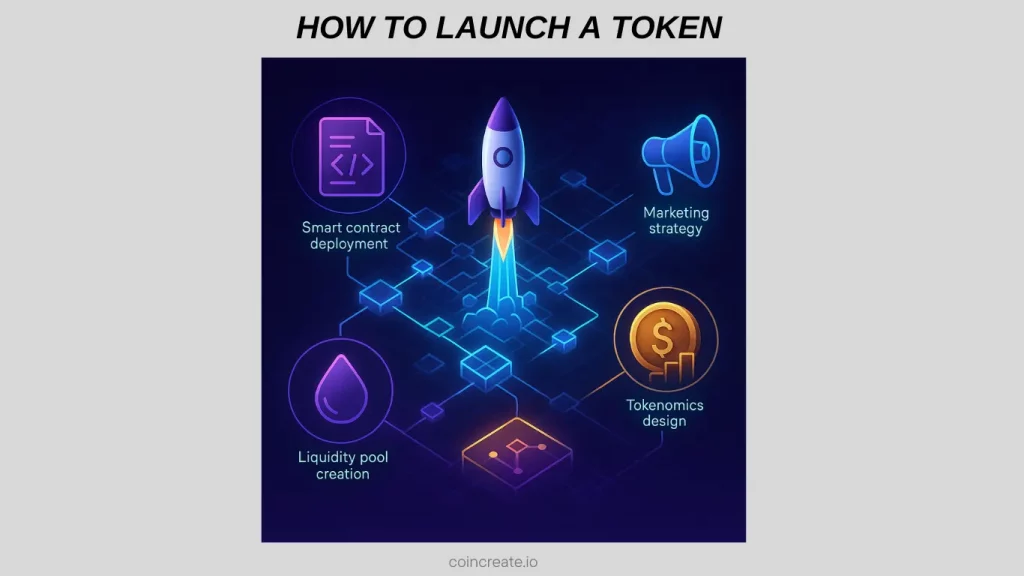How to Create Your Own Cryptocurrency?
Understanding Cryptocurrency Basics
Cryptocurrencies are digital assets built on blockchain technology, categorized primarily into coins and tokens, each serving distinct purposes. But what truly sets them apart and how do they function?

Key Concepts
Coins: The Foundation
Native to their own blockchain (e.g., Bitcoin on the Bitcoin Blockchain, Ether on Ethereum).
Function: Primarily used as a medium of exchange, store of value, or for transaction fees.
Examples: Bitcoin (BTC) – the original cryptocurrency, Ethereum (ETH) – enabling smart contracts, Cardano (ADA) – known for its PoS efficiency.
Analogy: Think of coins as the “native currency” of a digital nation.
Tokens: Versatile Assets
Built on existing blockchains (e.g., ERC-20 tokens on Ethereum).
Function: Serve specific functions like governance (voting rights), utility (access to a platform), or asset representation (real estate).
Examples: Uniswap (UNI) – governance token for the Uniswap exchange, Tether (USDT) – stablecoin pegged to USD, Chainlink (LINK) – provides data to smart contracts.
Analogy: Tokens are like specialized tickets or memberships within an existing digital ecosystem.
Blockchain Platforms: The Infrastructure
Ethereum: The most popular platform for tokens, supporting smart contracts and decentralized applications (dApps). Known for its flexibility and large community.
Spotlight: Ethereum’s transition to PoS (Proof of Stake) reduced energy consumption by over 99% [Source: Ethereum Foundation]
Binance Smart Chain (BSC): Another widely used blockchain for creating tokens and DeFi projects. Offers faster transaction times and lower fees compared to Ethereum.
Spotlight: BSC integrates seamlessly with Binance’s exchange ecosystem, enhancing liquidity.
Solana: Known for its high transaction speeds and low fees, making it suitable for high-frequency applications.
Spotlight: Solana boasts transaction speeds of up to 65,000 transactions per second (TPS)
[Source: Solana Labs]
Layer 2 Solutions: Scaling solutions that operate on top of existing blockchains to improve transaction speed and reduce costs. Examples include Polygon (Matic), Optimism, and Arbitrum.
Sidechains: Independent blockchains that run parallel to a main chain, often used to handle specific types of transactions or applications.
Consensus Mechanisms: Securing the Network
Proof of Work (PoW): A mining-based mechanism used by Bitcoin. Requires significant computational power to validate transactions.
Pros: Highly secure and decentralized.
Cons: High energy consumption and slow transaction times.
Proof of Stake (PoS): An energy-efficient mechanism where validators are chosen based on staked assets, used by Ethereum 2.0 and Cardano.
Pros: Environmentally friendly and faster transaction times.
Cons: Potential for centralization if a few large stakeholders control the majority of the stake.
Delegated Proof of Stake (DPoS): A variation of PoS where token holders delegate their stake to a smaller group of validators.
Feature Comparison: Coins vs. Tokens
| Feature | Coins | Tokens |
|---|---|---|
| Blockchain | Native to their blockchain | Built on existing blockchains |
| Purpose | Currency, transaction fees | Utility, governance, asset representation |
| Examples | Bitcoin, Ether | USDT, UNI |
Step-by-Step Guide to Create a Cryptocurrency
Creating a cryptocurrency involves technical expertise, strategic planning, and legal considerations. Here’s a simplified guide to help you develop your own coin or token.
Define the Purpose
Identify the problem your cryptocurrency aims to solve (e.g., faster transactions, privacy, or industry-specific use).
Establish its target audience and use cases.
Example: Filecoin solves decentralized storage, Chainlink solves data oracles for smart contracts.
Choose the Type
Coin: Requires creating a new blockchain (e.g., Bitcoin, Ethereum).
Token: Built on an existing blockchain like Ethereum (ERC-20) or Binance Smart Chain.
Decision Point: Consider the resources. Building a coin requires significantly more effort.
Select a Blockchain Platform
For tokens: Use platforms like Ethereum or Binance Smart Chain.
For coins: Develop your own blockchain using coding languages such as Solidity, Python, or C++.
Decide on the Consensus Mechanism
Choose between Proof of Work (PoW) for mining-based validation or Proof of Stake (PoS) for energy-efficient validation.
Trend: PoS is increasingly favored for environmental sustainability.
Design the Nodes
Set up nodes to verify transactions and maintain the blockchain network.
Decide on public/private permissions and hosting (cloud/on-premises).
Consideration: Cloud hosting offers scalability but may raise security concerns.
Develop Smart Contracts
Write smart contracts to define token rules (e.g., supply, transferability).
Use frameworks like Solidity for Ethereum-based tokens.
Create APIs
evelop APIs for interaction between your cryptocurrency and external applications.
Use third-party providers like BlockCypher or Bitcore if needed.
Insight: APIs enable seamless integration with exchanges and wallets.
Build the User Interface
Design a user-friendly wallet and interface for participants to interact with your cryptocurrency.
Use modern programming languages such as HTML5, JavaScript, or Python.
UX Tip: Focus on simplicity and security in wallet design.
Legal Compliance
Ensure adherence to regulatory requirements in your jurisdiction (e.g., KYC/AML laws).
Consult legal experts to avoid future complications.
Warning: Non-compliance can lead to severe penalties.
Launch and Market
Launch your cryptocurrency with a clear roadmap and whitepaper.
Promote it through social media, partnerships, and crypto communities.
Launch Strategy: Focus on building early traction and community support.
Examples of Tools and Frameworks
| Tool/Framework | Purpose |
|---|---|
| Solidity | Smart contract development |
| ERC-20 Standard | Token creation on Ethereum |
| BlockCypher API | Blockchain API integration |
| Visual Studio | IDE for blockchain coding |
Legal and Financial Considerations for Creating a Cryptocurrency
Legal Considerations
| Region | Regulatory Compliance |
|---|---|
| United States |
Cryptocurrencies are legal but subject to SEC regulations. Exchanges must comply with AML/CFT laws.
Source: SEC |
| European Union |
The MiCA framework provides a regulatory structure for crypto-assets, ensuring compliance across member states.
Source: European Commission |
| India | Cryptocurrency use is not explicitly banned but is heavily taxed. A bill to regulate private cryptocurrencies is pending. |
| Brazil | Cryptocurrencies are legal for payment purposes under the "Legal Framework for Virtual Assets" law. |
Legal Requirements
– Obtain necessary licenses for exchanges and trading platforms.
– Comply with AML/CFT regulations to prevent illicit activities.
– Ensure tax compliance based on local laws.
Pro-Tip: Consult local legal experts for tailored advice.
Financial Considerations
Cost Breakdown
| Item | Estimated Cost |
|---|---|
| Blockchain Development | $50,000 to $200,000 depending on complexity |
| Smart Contract Development | $10,000 to $50,000 |
| API Integration | $5,000 to $20,000 |
| Node Maintenance | $1,000 to $5,000 per month |
| Security Audits | $5,000 to $20,000 annually |
| Marketing and Promotion | $10,000 to $50,000 per month |
| Note: Costs vary based on the project's scope, technology choices, and market conditions. | |
Initial Investment
The initial investment to start a cryptocurrency project can range from $100,000 to $500,000, depending on the scope and complexity.
Marketing and Scaling Your Crypto Project: Strategies for Adoption
Successfully marketing and scaling a cryptocurrency project requires targeted strategies to build trust, grow your community, and drive adoption. Here are actionable steps based on proven methods
Build and Engage a Community
Platforms
Use community-centric platforms like Discord, Telegram, and Reddit to foster discussions and provide updates.
Strategies:
Host AMA (Ask Me Anything) sessions to engage directly with your audience.
Share regular updates about milestones, partnerships, and roadmap progress.
Use Telegram bots for FAQs or instant responses to user queries.
Community Management Tools: Consider using tools like Discord’s built-in features for moderation and engagement tracking.
Leverage Social Media
Platforms
Focus on crypto-friendly platforms like Twitter, YouTube, and Medium.
Strategies
Post consistent updates, news, and educational content tailored to your audience.
Use Twitter for announcements and Medium for detailed project insights.
Share milestones, airdrops, or events to generate buzz.
Content Strategy: Create explainer videos, infographics, and behind-the-scenes content.
Airdrops and Incentives
Distribute free tokens to early adopters or users who complete specific tasks (e.g., sharing posts, signing up).
Announce airdrops on social media to maximize reach while keeping tasks simple to encourage participation.
Use tools like DappRadar to track engagement metrics.
Legal Consideration: Ensure compliance with securities laws when distributing tokens.
Partner with Influencers
Collaborate with crypto influencers on platforms like YouTube or Twitter to boost credibility and reach new audiences.
Choose influencers aligned with your project’s goals and values for authentic promotion.
Due Diligence: Verify the authenticity and engagement metrics of influencers before partnering.
Content Marketing
Publish blogs, tutorials, and explainer videos on platforms like Medium or YouTube.
Educate users about your project’s unique value proposition while addressing common crypto concerns.
Optimize content for SEO to improve discoverability.
– SEO Tip: Focus on long-tail keywords and user intent.
Listings on Crypto Trackers
Get listed on platforms like CoinMarketCap or DappRadar to increase visibility.
Provide accurate project details, tokenomics, and links to official channels.
Listing Strategy: Ensure all information is up-to-date and consistent.
Paid Ads and PPC Campaigns
Run targeted ads on crypto-friendly platforms (e.g., Coinzilla) or search engines (consider Google’s crypto ad policies).
Focus on driving traffic to your website or landing pages with clear calls-to-action.
Compliance Note: Ad policies for crypto projects vary widely; stay informed.
Analytics and Feedback
Use tools like Google Analytics or Hootsuite to track campaign performance.
Gather community feedback through surveys or polls to refine strategies.
Iterative Approach: Continuously analyze and refine marketing efforts based on data and feedback.
Case Studies
Let’s examine a few successful cryptocurrencies and distill their key strategies:
– Bitcoin (BTC): First-mover advantage, strong decentralization, and scarcity (limited supply).
– Ethereum (ETH): Versatility through smart contracts, large developer community, and ongoing innovation.
– Binance Coin (BNB): Utility within the Binance ecosystem, frequent token burns to increase scarcity, and strong marketing efforts.
